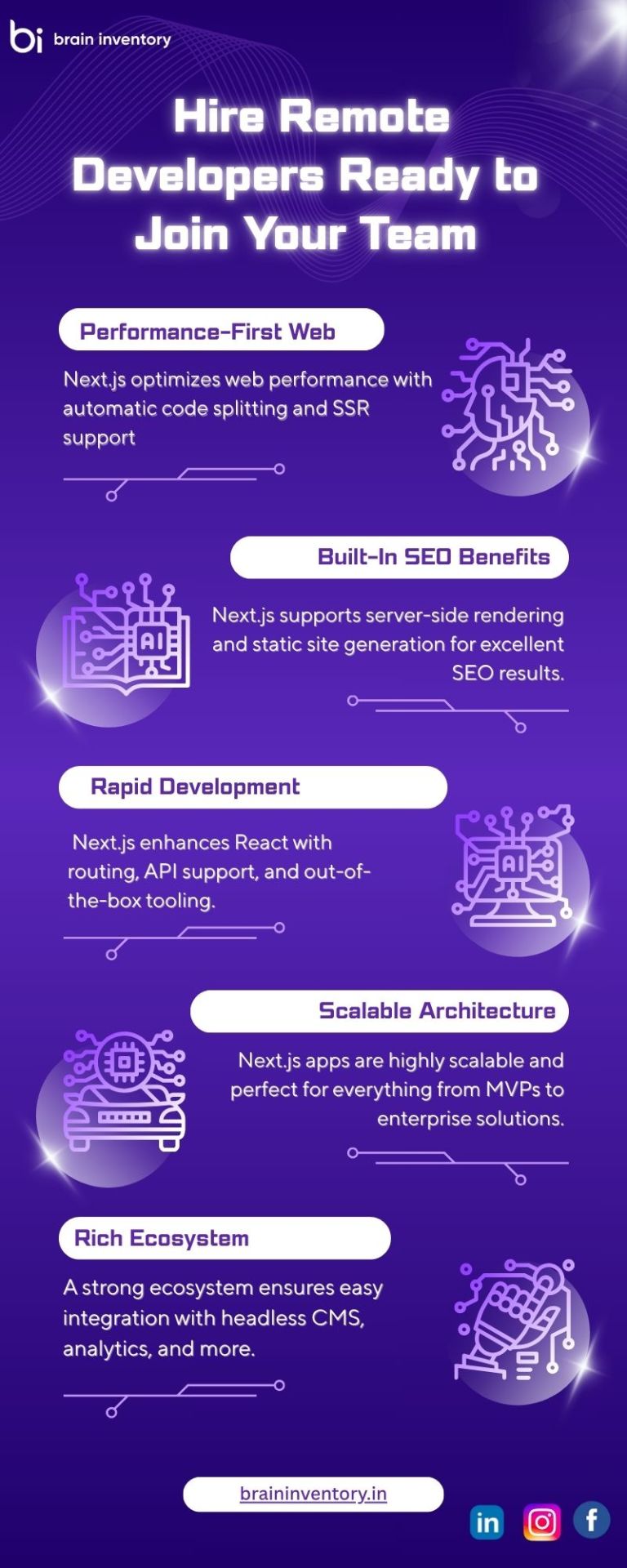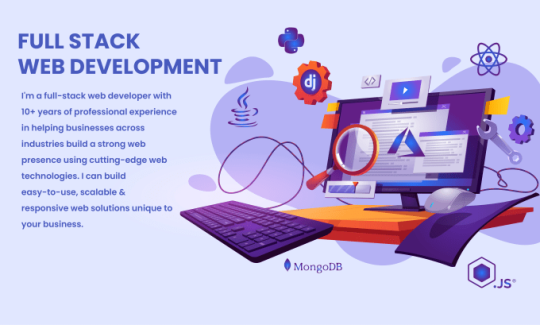#next js
Explore tagged Tumblr posts
Text
#digital aptech#reactjs#javaprogramming#javascript#coding#react.js#next.js#next js#reactjs development company#reactjs development services#reactjs developers#web development#app development#mobile app development#next.js development company
2 notes
·
View notes
Text
Hire Next.js Developers for Speed & SEO
Get top Next.js talent for high-speed, SEO-optimized web apps. Hire dedicated developers from Brain Inventory today.
For More Informmation Visit :-
0 notes
Text
Next.js for Enterprise-Grade Frontend: Performance Meets SEO
Enterprises today require web applications that are lightning-fast, scalable, SEO-friendly, and easy to maintain. Next.js has quickly become a go-to framework for organizations looking to build robust front-end applications with enterprise-grade performance.

Why Enterprises Choose Next.js
Next.js, built on top of React, brings powerful features like hybrid static & server-side rendering, image optimization, API routes, and smart bundling all out-of-the-box. This makes it an ideal fit for businesses where both user experience and SEO performance matter.
Key reasons why Next.js excels for enterprise-level development:
Improved SEO with server-side rendering (SSR) and static site generation (SSG)
Faster Load Times through automatic code-splitting and image optimization
Scalability due to its flexible architecture and dynamic routing
Developer Productivity supported by TypeScript, ESLint, and CI/CD compatibility
Testing Matters at Scale
As applications grow, automated testing becomes crucial. Enterprises often adopt tools like Jest with Next.js to implement robust testing pipelines. It allows teams to test components, API routes, and critical logic in isolation, reducing bugs and improving code quality.
The Talent Behind Scalable Projects
When performance and SEO are core business goals, companies need engineers who can implement advanced Next.js practices from the ground up. That’s why many enterprises hire Next.js developers with expertise in building scalable, SEO-friendly web apps using cutting-edge front-end technologies.
Conclusion
Next.js bridges the gap between performance and search visibility like no other framework. Whether you're building a high-traffic eCommerce store, a marketing site, or a SaaS dashboard, Next.js delivers the scalability and optimization your enterprise demands.
0 notes
Text

🚀 We're Hiring! Full Stack Engineer | Pune / Hybrid
Are you a passionate developer ready to make an impact? Join our dynamic, agile team at a leading service-based company and work with cutting-edge tech like Spring Boot, Next js, Docker, Kubernetes & more!
What You'll Do: ✅ Manage change releases & application lifecycle ✅ Debug, test and secure web applications ✅ Collaborate in a Scrum team ✅ Optimize performance with our SRE team
What We’re Looking For: 🔹 Strong full-stack dev skills (Java, TypeScript, REST, etc.) 🔹 Experience with PostgreSQL, MySQL or Oracle 🔹 Familiar with CI/CD, testing and Agile workflows 🔹 Excellent communication in English
🌟 Enjoy a stimulating environment, continuous learning and hands-on work with modern devops tools.
📧 Apply Now: Send your resume to [email protected]
#Hiring#FullStackEngineer#SoftwareJobs#TechCareers#PuneJobs#Java#TypeScript#Docker#Agile#SRE#Next js#JobAlert#NowHiring#SuntelGlobal#suntelglobal#HiringAlert#JobOpening#JobVacancies#Vacancy#JobOpportunity#JobSeekers#JobInterview#HiringNow#CareerOpportunity#JobsAvailable#ApplyNow#JobSearch#Recruiting
0 notes
Text
youtube
33 - PayPal Payment Integration - Step By Step [Next js 15, React 19, PostgreSQL , Prisma, ShadCN, PayPal, Stripe API integration] 🔥🔥 Free Source Code 🔥🔥 ---------------------------------- In this Session we'll be implementing PayPal payment integration
#youtube#nodejs#programming#angular#developer#softwarecompany#education#react#webdeveloper#tech#next js#react js
0 notes
Text
Eye to the Future: Powering Full-Stack Excellence with Java and React!

At Eye to the Future, REST API integration with a Java backend and a React frontend is a smart way to build modern, scalable, and efficient web applications. For a Java React developer, the backend, often powered by frameworks like Spring Boot, manages HTTP requests, routes, and data processing, ensuring secure and optimized responses. The frontend, built with React, connects seamlessly to these APIs using a component-based approach and hooks like useEffect to fetch and display data dynamically. This setup separates responsibilities, where the backend handles the data and the frontend focuses on user experience and presentation. JSON acts as the common data format, enabling smooth communication between the backend and frontend. Tools like Axios or the Fetch API in React make API calls easy, while handling errors and loading states ensures the application feels polished. Combining Java's backend strength and React's interactive frontend creates an end-to-end solution suitable for everything from small projects to large systems. With this robust integration, developers can easily adapt the skills to work as Next.js developers, bringing scalability and flexibility to any project.
0 notes
Text
Day 259 of Code: Getting Back on Track
It’s hard to believe it’s been 106 days since my last blog post on Day 153. I know, I know – it’s a long time to go without updating my progress. But to be honest, it’s tough to balance learning to code with writing about it. Sometimes, one has to take priority over the other, and unfortunately, my blogging habit took a backseat. However, that doesn’t mean I haven’t been coding. In fact, I’ve…

View On WordPress
#algorithms#coding challenges#coding journey#learning to code#mern stack#next js#oop programming#php#programming concepts#typescript#web development
0 notes
Text
Incerro Partners with Sanity to Accelerate Scalable Digital Solution Development
Introduction Incerro, a leading front-end agency and digital solution developer, is thrilled to announce its strategic partnership with Sanity, the modern headless CMS platform. Together, we are poised to redefine digital experiences. https://www.incerro.ai/insights/incerro-partners-with-sanity
#coding#sanity#partner#programming#software engineering#startup#application development#website development#front end development#website#software#next js#web design agency
0 notes
Text
Ajit Kumar : Web Developer | Laravel Developer | Php Developer | Next Js
Ajit Kumar : Web Developer | Laravel Developer | Php Developer | Next Js
0 notes
Text
https://selfgrowth.com/articles/angular-vs-nextjs-comparison
Make an educated choice between Angular and Next.js for your upcoming project by understanding their respective advantages and limitations through our in-depth comparison.
0 notes
Text



spreading hermitcat propaganda
#lmk who i should catify next heh#i js like kitties ☹️#this was rlly all a ploy to draw more mumbo kitty#hermitcat#hermitcraft#hermitblr#mumbo jumbo#grian#goodtimeswithscar#fanart#artist on tumblr#iveoy-art#waffle duo#desert duo#hermitcats
6K notes
·
View notes
Text
Hire Next.js Developers for Speed & Performance
Hire skilled Next.js developers to create fast, SEO-friendly web applications that elevate your digital presence.
for more information visit :-

0 notes
Text
How GraphQL Impacts Next.js App Performance
As modern web applications become increasingly dynamic and user-driven, data-fetching strategies have a direct influence on how well your frontend performs. For those building apps with Next.js, one of the most crucial architectural decisions revolves around the API layer: Should you use REST or GraphQL?
Let’s explore how GraphQL impacts Next.js app performance, when it makes sense to use it over REST, and why understanding this distinction could be the key to delivering fast, scalable, and responsive user experiences.
Why GraphQL? A Quick Recap

GraphQL is a query language for APIs that allows clients to request exactly the data they need, nothing more, nothing less. This selective fetching reduces data over-fetching and under-fetching, which are common limitations of traditional REST APIs.
In Next.js apps, where server-side rendering (SSR) and static site generation (SSG) can coexist with client-side rendering (CSR), the way data is fetched is pivotal.
To understand the fundamental differences between REST and GraphQL in Next.js workflows, check out this detailed guide on REST vs GraphQL in Next.js.
1. Faster Time-to-First-Byte with SSR and GraphQL
Next.js apps often use getServerSideProps() to fetch data at request time. REST APIs might send too much or too little data, requiring additional client-side fetches. GraphQL avoids this by allowing:
A single endpoint query
Fine-tuned data requirements
Elimination of N+1 queries through batching and nesting
This precision helps reduce server response times and boosts Time to First Byte (TTFB)—a key metric for performance.
2. Reduced Client Payload = Faster UI Rendering
Next.js promotes CSR for highly interactive interfaces. But client-side fetches can weigh down performance when APIs return bulky data. GraphQL helps by:
Sending minimal payloads
Returning nested objects in a single request
Allowing front-end components to define exactly what data they need
This leads to faster hydration and less time spent processing unneeded data, enhancing both perceived and real performance.
3. API Flexibility for SSG and ISR
For statically generated pages using getStaticProps(), data requirements are known at build time. GraphQL makes this easier:
Fetch multiple entities in one query
Avoid multiple API calls during static builds
Reduce build times for large-scale content applications
This is particularly useful for Next.js sites using Incremental Static Regeneration (ISR) to update specific pages without a full rebuild.
4. Simplified Caching with GraphQL Clients
Modern GraphQL clients (like Apollo, Relay, or urql) integrate seamlessly with Next.js and come with built-in caching strategies. This means:
Reduced network calls
Improved perceived performance
Automatic cache invalidation with minimal config
5. Handling Complex Relationships with Less Overhead
REST APIs often require multiple round-trips to fetch related entities. For instance, fetching a blog post and its author details requires two or more REST calls. GraphQL fetches nested relations in a single query:
graphql
{
post(id: "123") {
title
content
author {
name
avatar
}
}
}
In a Next.js page, this single request improves load speed and simplifies code, especially during SSR.
Final Thoughts
GraphQL can significantly improve Next.js app performance but only when used appropriately. Its fine-grained data fetching, reduced payload sizes, and ability to power both SSR and CSR efficiently make it a strong fit for complex applications that demand speed and scalability.When performance is critical to your app’s success, consider partnering with experts who understand the nuances of both GraphQL and Next.js. Whether you’re starting fresh or scaling up, it’s a smart move to hire Next.js developers who know how to architect performant, modern web applications from the ground up.
0 notes
Text

I excel in swift web development utilizing the Django framework, React, Redux, Next.js, and Angular. Over the experience of 9 years, I have honed my skills working extensively with Python, Django framework, Django Rest framework, and various other Python-based technologies. My proficiency extends to comprehending SQL databases, REST APIs, and implementing robust security measures.
0 notes
Text
Dynamic and Responsive Web Applications with Next.js and Mongoose
In the fast-paced realm of web development, the ability to create dynamic and responsive applications is a critical skill. This blog post will guide you through the process of initiating a project using Next.js, a popular React framework, paired with MongoDB and Mongoose for robust database management. By the end of this guide, you'll have a solid foundation to propel your web application towards success.
Key Features:
Server-Side Rendering (SSR):
Next.js excels in server-side rendering, generating pages on the server before reaching the client. SSR enhances performance, boosts SEO, and ensures a smoother initial loading experience for users.
Static Site Generation (SSG):
Leveraging Next.js, static site generation pre-builds pages at compile time, serving them as static files. Ideal for content-heavy websites, this approach ensures swift loading times and efficient caching.
API Routes:
The ability to create API routes directly within your project simplifies the development of serverless functions and backend functionality with Next.js.
CSS-in-JS Support:
Enjoy built-in support for various CSS-in-JS solutions, such as Styled Components or Emotion, making styling your components a seamless process.
Environment Variable Support:
Next.js supports the use of environment variables for configuration, allowing you to manage different settings across development, staging, and production environments.
Mongoose Introduction:
Key Features:
Schema Definition:
Define a schema for MongoDB documents using Mongoose, creating a clear structure for the data. Schemas specify the data's shape, including field types, default values, and validation rules.
Data Validation:
Mongoose incorporates built-in validation, ensuring documents meet specific criteria before being saved to the database. Apply validation rules to individual fields for robust data integrity.
Middleware:
Mongoose supports middleware functions, enabling custom logic before or after events like saving a document or querying the database. Middleware is a powerful tool for encapsulating business logic within your models.
Query Building:
Simplify the creation of complex MongoDB queries with Mongoose's fluent API. Build queries effortlessly using methods like find, findOne, and update, streamlining interactions with the database.
Connection Management:
Mongoose efficiently manages database connections, providing a straightforward way to connect to MongoDB and handle connection events. With built-in connection pooling, resource usage is optimized.
The fusion of Next.js and Mongoose streamlines web development, facilitating efficient, scalable applications. Leveraging their strengths, developers craft SEO-friendly, interactive experiences with seamless data handling. This integration empowers developers to build compelling, modern applications amid evolving web development paradigms.
0 notes
Text
youtube
Next.Js 15/ React 19 - eCommerce Complete Project [PostgreSQL, Prisma, ShadCN-UI, Paypal, Stripe integration] https://youtu.be/78B6UV-Xk80
#youtube#nodejs#programming#education#developer#webdeveloper#angular#react#softwarecompany#tech#next js#react js
0 notes